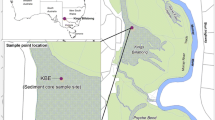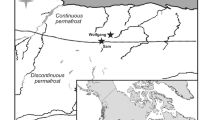Abstract
We studied multiple variables in a sediment core from Lake Kipojärvi, northern Finland, to investigate Holocene ecosystem changes in relation to catchment characteristics and known climate variations. We focused on a forested catchment because previous paleolimnological studies conducted in Fennoscandia focused mainly on subarctic lakes within a range of shifting treeline(s). Data on aquatic macrophytes, diatoms, Cladocera, C:N ratio, organic matter (LOI) and regional vegetation (pollen), revealed a three-phase limnological development. The early Holocene, species-rich, mesotrophic lake was transformed into an oligotrophic, species-poor aquatic ecosystem by the early middle Holocene, ca. 7,500 cal years BP, earlier than has generally been reported. The transition involved considerable changes in aquatic macrophytes. Changes in the Cladocera and diatom communities appear to have been linked to aquatic macrophyte development, which in turn, was probably regulated by catchment development and hydrology, and a consequent decrease in nutrient input from the catchment. During the more humid late Holocene, surface flow from the catchment probably increased, but the lake’s nutrient status remained oligotrophic. Possible reasons for low nutrient concentration in the late Holocene include: 1) slower biogeochemical cycling due to cooler climate, 2) a new hydrologic outlet and associated shorter water-retention times, and 3) accelerated peatland development in the catchment that affected water flow patterns and nutrient cycling.







Similar content being viewed by others
References
Barnekow L (2000) Holocene regional and local vegetation history and lake-level changes in the Torneträsk area, northern Sweden. J Paleolimnol 23:399–420
Bennett K (1996) Determination of the number of zones in a biostratigraphical sequence. New Phytol 132:155–170
Birks HH (2000) Aquatic macrophyte vegetation development in Kråkenes Lake, western Norway, during the late-glacial and early-holocene. J Paleolimnol 23:7–19
Birks HJB, Gordon AD (1985) Numerical methods in quaternary pollen analysis. Academic Press, London
Birks HH, Battarbee RW, Birks HJB (2000) The development of the aquatic ecosystem at Kråkenes Lake, western Norway, during the late-glacial and early-holocene—a synthesis. J Paleolimnol 23:91–114
Bjerring R, Becares E, Declerck S, Gross EM, Hansson L-A, Kairesalo T, Nykänen M, Halkiewicz A, Kornijow R, Conde-Porcuna JM, Seferlis M, Nöges T, Moss B, Amsinck SL, Odgaard BV, Jeppesen E (2009) Subfossil Cladocera in relation to contemporary environmental variables in 54 Pan-European lakes. Freshwat Biol 54:2401–2417
Brodersen KP, Whiteside MC, Lindegaard C (1998) Reconstruction of trophic state in Danish lakes using subfossil chydorid (Cladocera) assemblages. Can J Fish Aquat Sci 55:1093–1103
Carpenter SR, Lodge DM (1986) Effects of submersed macrophytes on ecosystem processes. Aquat Bot 26:341–370
Coops H (2002) Ecology of charophytes: an introduction. Aquat Bot 72:205–208
Davidson T, Sayer C, Perrow M, Bramm M, Jeppesen E (2007) Are the controls of species composition similar for contemporary and sub-fossil cladoceran assemblages? A study of 39 shallow lakes of contrasting trophic status. J Paleolimnol 38:117–134
de Eyto E, Irvine K, Garcia-Criado F, Gyllström M, Jeppesen E, Kornijow R, Miracle MR, Nykänen M, Bareiss C, Cerbin S, Salujõe J, Franken R, Stephens D, Moss B (2003) The distribution of chydorids (Branchiopoda, Anomopoda) in European shallow lakes and its application to ecological quality monitoring. Arch Hydrobiol 156:181–202
Denys L (1990) Fragilaria blooms in the holocene of the western coastal plain of Belgia. In: Simola H (ed) Proceedings of the tenth international diatom symposium, Joensuu, Finland, 28th August–2nd September 1988. Koeltz Scientific Books, Koenigstein, pp 397–406
Dodson SI, Arnott SE, Cottingham KL (2000) The relationship in lake communities between productivity and species richness. Ecology 81:2662–2679
Fægri K, Iversen J (1989) Textbook of pollen analysis. Wiley, Chichester
Forsberg C (1992) Will an increased greenhouse impact in Fennoscandia give rise to more humic and colored lakes? Hydrobiologia 229:51–58
Hannon GE, Gaillard M-J (1997) The plant-macrofossil record of past lake-level changes. J Paleolimnol 18:15–28
Hessen DO, Gjessing EG, Knulst J, Fjeld E (1997) TOC fluctuations in a humic lake as related to catchment acidification, season and climate. Biogeochemistry 36:139–151
Hyvärinen H (1975) Absolute and relative pollen diagrams from northernmost Fennoscandia. Fennia 142:1–23
Jeppesen E, Jensen JP, Søndergaard M, Lauridsen T, Pedersen LJ, Jensen L (1997) Top-down control in freshwater lakes: the role of nutrient state, submerged macrophytes and water depth. Hydrobiologia 342–343:151–164
Juggins S (2001) The European diatom database, user guide, version 1.0
Juggins S (2003) C2 user guide. Software for ecological and paleoecological data analysis and visualization. University of Newcastle, Newcastle Upon Tyne
Korhola A (1990) Paleolimnology and hydroseral development of the Kotasuo bog, Southern Finland, with special reference to the Cladocera. Ann Acad Sci Fenn A III 155:1–40
Korhola A, Tikkanen M, Weckström J (2005) Quantification of the holocene lake-level changes in Finnish Lapland by means of a cladocera-lake depth transfer model. J Paleolimnol 34:175–190
Korhola A, Seppä H, Ruppel M, Väliranta M, Virtanen T, Weckström J (2010) The importance of northern peatland expansion to the late-holocene rise of atmospheric methane. Quat Sci Rev 29:611–617
Korsman T, Segerström U (1998) Forest fire and lake-water acidity in a northern Swedish boreal area: holocene changes in lake-water quality at Makkassjön. J Ecol 86:113–124
Krammer K, Lange-Bertalot H (1986–1991) Bacillariophyceae. In: Ettl H, Gerloff J, Heynig H, Mollenhauer D (eds) Süßwasserflora von Mitteleuropa, vol 2 (1–4). Gustav Fischer Verlag, Stuttgart/Jena
Lampinen R, Lahti T (2007) Kasviatlas 2006. Botanical Museum, Finnish Museum of Natural History. Helsinki. [Digital atlas of vascular plants in Finland at: http://www.luomus.fi/kasviatlas]
Lotter AF, Birks HJB (2003) The holocene paleolimnology of Sägistalsee and its environmental history—a synthesis. J Paleolimnol 30:333–342
Lotter AF, Juggins S (1991) PLOPROF, TRAN and ZONE. Programs for plotting, editing and zoning of pollen and diatom data. INQUA Commission for the study of the Holocene, Working Group on Data Handling Methods, Newsletter 6
Mattsson T (2010) Export of organic matter, sulfate and base cations from boreal headwater catchments downstream to the coast: impacts of land use and climate. Monograph Boreal Environ Res 36:1–45
Økland KA, Økland J (2000) Freshwater bryozoans (Bryozoa) of Norway: distribution and ecology of Cristatella mucedo and Paludicella articulate. Hydrobiologia 421:1–24
Pienitz R, Smol JP, MacDonald GM (1999) Paleolimnological reconstruction of holocene climatic trends from two boreal treeline lakes, Northwest territories Canada. Arct Antarc Alp Res 31:82–93
Qualls RG, Richardson CJ (2003) Factors controlling concentration, export, and decomposition of dissolved organic nutrients in the Everglades of Florida. Biogeochemistry 62:197–229
Rintanen T (1976) Lake studies in eastern Finnish Lapland. I. Aquatic flora: Phanerogams and Charales. Ann Bot Fennici 13:137–148
Rørslett B (1991) Principal determinants of aquatic macrophytes richness in northern European lakes. Aquat Bot 39:173–193
Rosén P, Segerström U, Eriksson L, Renberg I, Birks HJB (2001) Holocene climatic change reconstructed from diatoms, chironomids, pollen and near-infrared spectroscopy at an alpine lake (Sjuodjijaure) in northern Sweden. Holocene 11:551–562
Sandoy S, Nilssen JP (1986) A geographical survey of littoral crustacea in Norway and their use in paleolimnology. Hydrobiologia 143:277–286
Sarmaja-Korjonen K, Hyvärinen H (1999) Cladoceran and diatom stratigraphy of calcerous lake sediments from Kuusamo, NE Finland. Indications of holocene lake level changes. Fennia 177:55–70
Sarmaja-Korjonen K, Nyman M, Kultti S, Väliranta M (2006) Palaeolimnological development of Lake Njargajavri, Northern Finnish Lapland, in a changing holocene climate and environment. J Paleolimnol 34:203–215
Sayer C, Roberts N, Sadler J, David C, Wade PM (1999) Biodiversity changes in a shallow lake ecosystem: a multi-proxy palaeolimnological analysis. J Biogeogr 26:97–114
Seppä H (1998) Postglacial trends in palynological richness in the northern Fennoscandian tree-line area and their ecological interpretation. Holocene 8:43–53
Seppä H, Birks HJB (2001) July mean temperature and annual precipitation trends during the holocene in the Fennoscandian tree-line area: pollen-base climate reconstruction. Holocene 11:527–539
Seppä H, Hammarlund D (2000) Pollen-stratigraphical evidence of holocene hydrological change in northern Fennoscandia supported by independent isotopic data. J Paleolimnol 24:69–79
Seppä H, Hicks S (2006) Integration of modern and past pollen accumulation rate (PAR) records across the arctic tree-line: a method for more precise vegetation reconstructions. Quat Sci Rev 25:1501–1516
Seppä H, Weckström J (1999) Holocene vegetational and limnological changes in the Fennoscandian tree-line area as documented by pollen and diatom records from Lake Tsuolbmajavri, Finland. Écoscience 6:621–635
Simpson EH (1949) Measurement of diversity. Nature 163:688
Smol JP (1988) Paleoclimate proxy data from freshwater arctic diatoms. Verh Int Ver Limnol 23:837–844
Stockmarr J (1971) Tablets with spores used in absolute pollen analysis. Pollen Spores 13:615–621
Stuiver M, Reimer PJ (1993) Extended 14C data base and revised CALIB 3.0 14C age calibration program. Radiocarbon 35:215–230
Szeroczyńska K, Sarmaja-Korjonen K (2007) Atlas of subfossil Cladocera from Central and Northern Europe. Friends of the Lower Vistula Society, Świecie
Tranvik LJ, Jansson M (2002) Climate change (Communication arising): terrestrial export of organic carbon. Nature 415:861–862
Vähätalo AV, Salonen K, Munster U, Järvinen M, Wetzel RG (2003) Photochemical transformation of allochthonous organic matter provides bioavailable nutrient in a humic lake. Arch Hydrobiol 156:287–314
Väliranta M (2006) Long-term changes in aquatic plant species composition in North-eastern European Russia and Finnish Lapland, as evidenced by plant macrofossil analysis. Aquat Bot 85:224–232
Väliranta M, Kultti S, Nyman M, Sarmaja-Korjonen K (2005) Holocene development of aquatic vegetation in a shallow Lake Njargajavri, Finnish Lapland with evidence of water level fluctuations and drying. J Paleolim 34:203–215
van Donk E, van de Bund WJ (2002) Impact of submerged macrophytes including charophytes on phyto and zooplankton communities: allelopathy versus other mechanisms. Aquat Bot 72:261–274
Velle G, Larsen J, Eide W, Peglar S, Birks HJB (2005) Holocene environmental history and climate of Råtåsjøen, a low-alpine lake in south-central Norway. J Paleolimnol 33:129–153
Weckström J, Seppä H, Korhola A (2010) Climatic influence on peatland formation and lateral expansion dynamics in subarctic Fennoscandia. Boreas 39:761–769
Weckström J (2001) Assessment of diatoms as markers of environmental change in northern Fennoscandia. Unpublished Ph.D. dissertation, University of Helsinki, Helsinki
Wetzel R (2001) Limnology. Academic press, San Diego
Acknowledgments
Funding was provided to MV and JW by the REBECCA-project, supported by the Helsinki University Environmental Research Centre (HERC) and the Academy of Finland. We gratefully acknowledge funding to SS from Arctic Doctoral Programme, Arctic Centre, University of Lapland. We warmly thank Mirjam Orvomaa and Virpi Kuutti for help with fieldwork and analyses. We are grateful to Ossi Aikio and many other local people for their helpful and cooperative attitude towards our fieldwork in Kaamanen.
Author information
Authors and Affiliations
Corresponding author
Rights and permissions
About this article
Cite this article
Väliranta, M., Weckström, J., Siitonen, S. et al. Holocene aquatic ecosystem change in the boreal vegetation zone of northern Finland. J Paleolimnol 45, 339–352 (2011). https://doi.org/10.1007/s10933-011-9501-5
Received:
Accepted:
Published:
Issue Date:
DOI: https://doi.org/10.1007/s10933-011-9501-5




